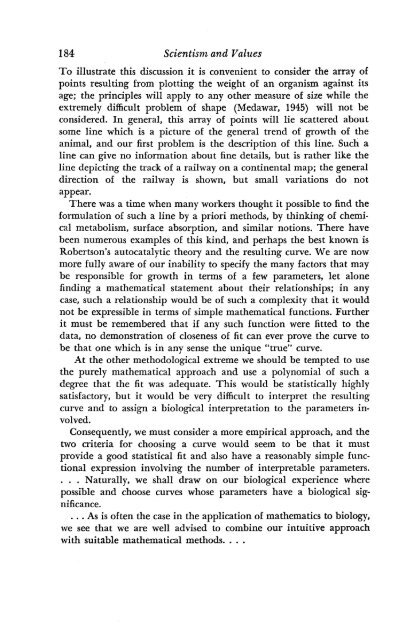Scientism and Values.pdf - Ludwig von Mises Institute
Scientism and Values.pdf - Ludwig von Mises Institute
Scientism and Values.pdf - Ludwig von Mises Institute
You also want an ePaper? Increase the reach of your titles
YUMPU automatically turns print PDFs into web optimized ePapers that Google loves.
184 <strong>Scientism</strong> <strong>and</strong> <strong>Values</strong><br />
To illustrate this discussion it is convenient to consider the array of<br />
points resulting from plotting the weight of an organism against its<br />
age; the principles will apply to any other measure of size while the<br />
extremely difficult problem of shape (Medawar, 1945) will not be<br />
considered. In general, this array of points will lie scattered about<br />
some line which is a picture of the general trend of growth of the<br />
animal, <strong>and</strong> our first problem is the description of this line. Such a<br />
line can give no information about fine details, but is rather like the<br />
line depicting the track of a railway on a continental map; the general<br />
direction of the railway is shown, but small variations do not<br />
appear.<br />
There was a time when many workers thought it possible to find the<br />
fonnulation of such a line by a priori methods, by thinking of chemical<br />
metabolism, surface absorption, <strong>and</strong> similar notions. There have<br />
been numerous examples of this kind, <strong>and</strong> perhaps the best known is<br />
Robertson's autocatalytic theory <strong>and</strong> the resulting curve. We are now<br />
more fully aware of our inability to specify the many factors that may<br />
be responsible for growth in terms of a few parameters, let alone<br />
finding a mathematical statement about their relationships; in any<br />
case, such a relationship would be of such a complexity that it would<br />
not be expressible in terms of simple mathematical functions. Further<br />
it must be remembered that if any such function were fitted to the<br />
data, no demonstration of closeness of fit can ever prove the curve to<br />
be that one which is in any sense the unique "true" curve.<br />
At the other methodological extreme we should be tempted to use<br />
the purely mathematical approach <strong>and</strong> use a polynomial of such a<br />
degree that the fit was adequate. This would be statistically highly<br />
satisfactory, but it would be very difficult to interpret the resulting<br />
curve <strong>and</strong> to assign a biological interpretation to the parameters involved.<br />
Consequently, we must consider a more empirical approach, <strong>and</strong> the<br />
two criteria for choosing a curve would seem to be that it must<br />
provide a good statistical fit <strong>and</strong> also have a reasonably simple functional<br />
expression involving the number of interpretable parameters.<br />
. . . Naturally, we shall draw on our biological experience where<br />
possible <strong>and</strong> choose curves whose parameters have a biological significance.<br />
. . . As is often the case in the application of mathematics to biology,<br />
we see that we are well advised to combine our intuitive approach<br />
with suitable mathematical methods....
















